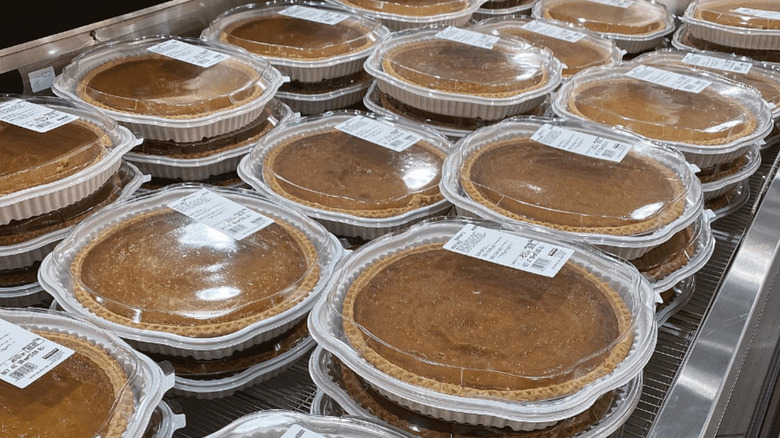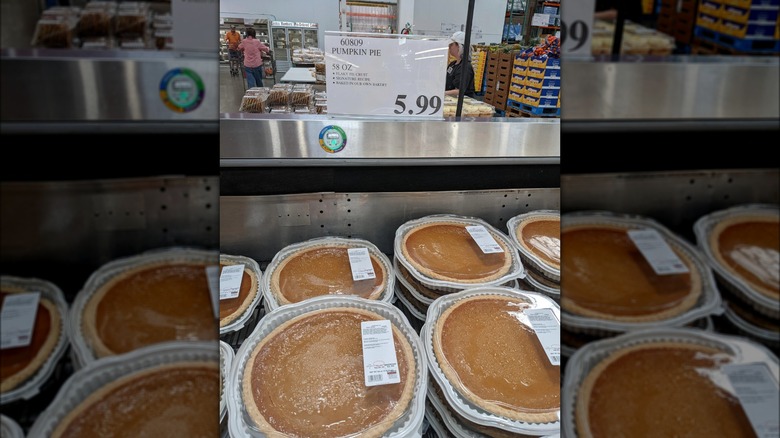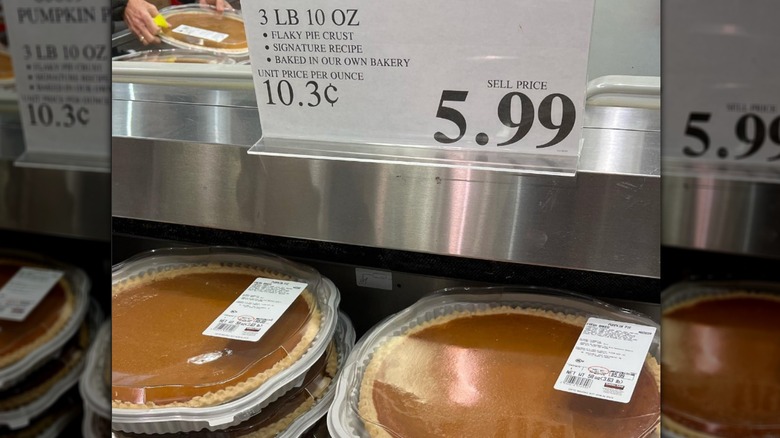How Costco Keeps Its Giant Pies So Cheap
Almost as iconic as Costco's $1.50 food court hot dog or $5 rotisserie chicken are its Thanksgiving-special pumpkin pies. These massive desserts, weighing in at a whopping 3.6 pounds and measuring a staggering 12 inches in diameter, have become a staple on Thanksgiving tables across the country. For their size and weight, though, the price tag stuck to each box seems kind of shocking: Only $5.99 a pop. And this price hasn't changed since 1990, too, which makes the pie as inflation-proof as the other legendary Costco treats mentioned earlier. Naturally, you'd be asking yourself how on Earth Costco was able to keep the pies so cheap.
According to David and Susan Schwartz, authors of "The Joy of Costco: A Treasure Hunt From A to Z," the secret lies in Costco's streamlined and highly efficient pumpkin pie production process. Every step of the way is meticulously designed to achieve a singular goal: Producing high-quality pies at the lowest possible cost without compromising on taste or quality.
The keys are bulk-buying and streamlining
Costco, being a wholesaler, naturally has massive buying power. It can secure bulk ingredients at significantly discounted rates. That's exactly what it did here with its pumpkin pies. From the flour and sugar to the pumpkin puree itself, Costco negotiated on its members' behalf and stamped out better deals with suppliers to help keep costs down. In fact, it's the reason why if you were to attempt baking a homemade pumpkin pie of similar size and weight, the cost of ingredients alone would likely exceed Costco's $5.99 price tag!
Another secret behind Costco's affordable pumpkin pies lies in its nearly industrialized production process. All ingredients are shipped to a central kitchen, where skilled bakers handcraft the pie crusts, meticulously pressing them into each tin. The tin is then passed down the line to a specialized machine that mixes and portions the ingredients before filling the crust with the perfect amount of spiced pumpkin filling. This automation not only speeds up the process but also minimizes waste, reduces cost, and is the reason why every pie looks the same no matter which box you pick from the shelves!
The special pumpkin for the pie is a big cost-saver
The real secret behind each pie with a flaky, buttery crust and velvety pumpkin-spiced filling? The Dickinson pumpkin. This is a special kind of pumpkin that's grown in central Illinois and is mostly used to make canned pumpkins. Unlike normal, orange-ish field pumpkins that you'd find at the farmer's market with juicy, stringy flesh, Dickinson pumpkins have drier flesh that's quite smooth. This makes them especially suited for baking — and the reason why Costco chose this kind of pumpkin specially to buy in bulk and mix their pumpkin pie filling. Per David and Susan Schwartz's book, Costco goes through 1.2 million cans of Dickinson pumpkin each season!
While we're not privy to the exact details of the deals made between Costco and its pumpkin suppliers, it's very likely to be a pretty significant cost-saver. Canned, processed, and tacked with a volume discount, Costco can get a lot of these pumpkins for pennies on the dollar rather than buying and using fresh pumpkins for the filling.
In any case, with its generous size and unbeatable value (larger and cheaper than store-bought pumpkin pies sold at other chains), it's no wonder that Costco ships out a staggering number of these pies annually — about 6 million between November and Christmas each year.


